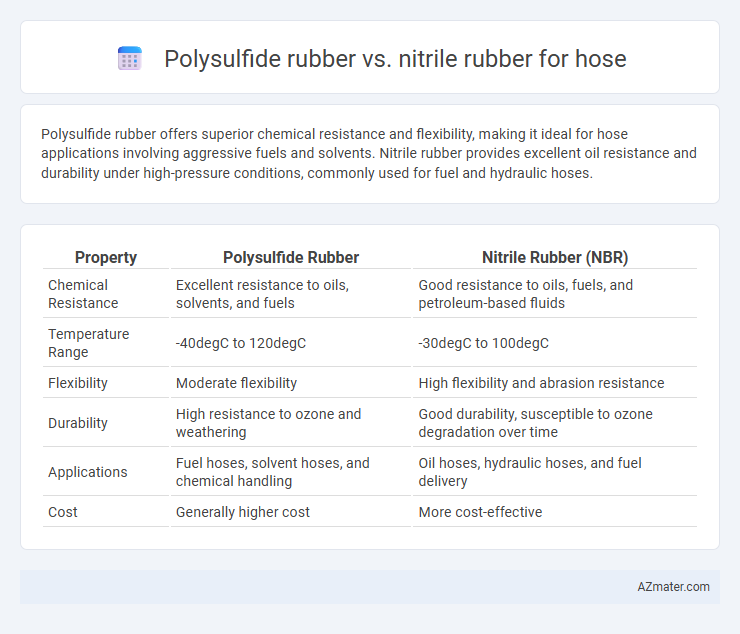Polysulfide rubber offers superior chemical resistance and flexibility, making it ideal for hose applications involving aggressive fuels and solvents. Nitrile rubber provides excellent oil resistance and durability under high-pressure conditions, commonly used for fuel and hydraulic hoses.
Table of Comparison
| Property | Polysulfide Rubber | Nitrile Rubber (NBR) |
|---|---|---|
| Chemical Resistance | Excellent resistance to oils, solvents, and fuels | Good resistance to oils, fuels, and petroleum-based fluids |
| Temperature Range | -40degC to 120degC | -30degC to 100degC |
| Flexibility | Moderate flexibility | High flexibility and abrasion resistance |
| Durability | High resistance to ozone and weathering | Good durability, susceptible to ozone degradation over time |
| Applications | Fuel hoses, solvent hoses, and chemical handling | Oil hoses, hydraulic hoses, and fuel delivery |
| Cost | Generally higher cost | More cost-effective |
Introduction to Polysulfide and Nitrile Rubber
Polysulfide rubber is a synthetic elastomer known for its exceptional resistance to chemicals, solvents, and weathering, making it ideal for hoses exposed to harsh environments. Nitrile rubber, also called Buna-N, offers superior oil, fuel, and abrasion resistance, commonly used in hose applications involving petroleum-based fluids. Both materials provide elasticity and durability, but polysulfide excels in resistance to oxidative aging, while nitrile is favored for its balance of performance and cost-effectiveness in fuel handling.
Chemical Composition and Structure
Polysulfide rubber consists of linear polysulfide chains linked by sulfur atoms, providing excellent chemical resistance and flexibility, especially against solvents and fuels. Nitrile rubber is a copolymer of acrylonitrile and butadiene, offering superior resistance to oils, grease, and hydrocarbons due to its polar nitrile groups. The sulfur-sulfur bonds in polysulfide rubber enhance durability in harsh chemical environments, while the polar nitrile groups in nitrile rubber improve impermeability and mechanical strength for hose applications.
Key Physical Properties Comparison
Polysulfide rubber exhibits superior chemical resistance and excellent resistance to oils, solvents, and weathering, making it ideal for hoses exposed to aggressive environments. Nitrile rubber provides outstanding tensile strength, abrasion resistance, and resistance to petroleum-based fluids, ensuring durability and flexibility under high pressure and mechanical stress. Both materials offer distinct advantages, with polysulfide rubber excelling in chemical stability and nitrile rubber favored for mechanical toughness and oil resistance.
Resistance to Chemicals and Oils
Polysulfide rubber offers superior resistance to a broad spectrum of chemicals, including strong acids and solvents, making it ideal for hoses exposed to aggressive industrial fluids. Nitrile rubber excels in resistance to oils, fuels, and hydrocarbons, providing excellent durability in automotive and oil handling applications. Selecting between polysulfide and nitrile rubber hinges on the specific chemical environment, with polysulfide favored for chemical resistance and nitrile for oil resistance in hose construction.
Temperature Tolerance and Performance
Polysulfide rubber exhibits superior temperature tolerance, maintaining flexibility and chemical resistance in temperatures ranging from -40degC to 120degC, making it ideal for high-heat hose applications. Nitrile rubber, with a temperature range of approximately -40degC to 100degC, offers excellent resistance to oils and fuels but may degrade faster under extreme heat conditions compared to polysulfide rubber. Hose performance in high-temperature environments favors polysulfide rubber due to its enhanced durability and resistance to thermal aging and chemical exposure.
Flexibility and Mechanical Strength
Polysulfide rubber offers superior mechanical strength with excellent resistance to abrasion and chemical exposure, making it ideal for hoses requiring durability under harsh conditions. Nitrile rubber excels in flexibility, providing outstanding resistance to oils, fuels, and greases, which ensures enhanced flexibility and performance in dynamic hose applications. When selecting hose materials, polysulfide rubber suits heavy-duty uses demanding toughness, while nitrile rubber is preferred for applications emphasizing flexibility and resistance to petroleum-based fluids.
Durability and Longevity in Hoses
Polysulfide rubber offers superior chemical resistance and exceptional durability in harsh environments, making it highly suitable for hoses exposed to fuels, oils, and solvents. Nitrile rubber excels in abrasion resistance and maintains flexibility at low temperatures, ensuring long service life in applications involving oils and fuels with moderate mechanical stress. For hose longevity, polysulfide rubber withstands oxidative and thermal degradation better, while nitrile rubber provides resilient performance against oil permeation and wear.
Cost Considerations and Availability
Polysulfide rubber hoses generally incur higher production costs due to complex vulcanization processes and limited raw material availability, leading to elevated market prices. Nitrile rubber hoses benefit from widespread manufacturing and abundant nitrile butadiene availability, resulting in lower costs and more consistent supply chains. Cost-sensitive industries often prefer nitrile hoses for economic efficiency, while polysulfide hoses are reserved for specialized applications despite their premium pricing.
Typical Applications in Hose Manufacturing
Polysulfide rubber excels in hose manufacturing for applications requiring exceptional chemical resistance, especially against fuels, oils, and solvents in automotive and aerospace industries. Nitrile rubber (NBR) is widely used in hoses designed for oil transfer, fuel delivery, and hydraulic systems due to its superior resistance to petroleum-based fluids and good abrasion tolerance. Both materials are favored for durable, flexible hoses, with polysulfide rubber preferred for higher chemical stability and nitrile rubber chosen for cost-effective oil resistance.
Choosing the Right Rubber for Your Hose Needs
Polysulfide rubber offers excellent resistance to ozone, weathering, and many solvents, making it ideal for hoses exposed to harsh environmental conditions. Nitrile rubber excels in oil resistance and durability against fuels and hydrocarbons, well-suited for industrial and automotive hose applications. Selecting the right rubber depends on the hose's exposure environment, chemical compatibility, and required flexibility, ensuring optimal performance and longevity.

Infographic: Polysulfide rubber vs Nitrile rubber for Hose
 azmater.com
azmater.com